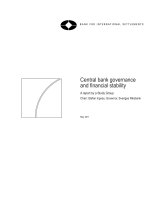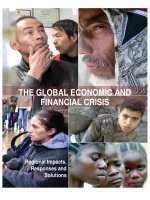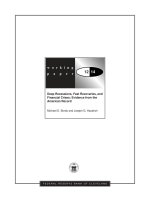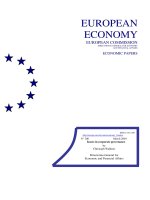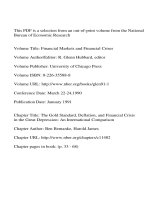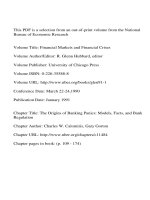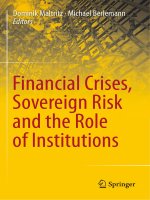Desai said (eds ) global governance and financial crises (2004)
Bạn đang xem bản rút gọn của tài liệu. Xem và tải ngay bản đầy đủ của tài liệu tại đây (813.57 KB, 176 trang )
Global Governance and
Financial Crises
Are global financial markets rational or are manias possible? Should crises be
allowed to run their course and purge the system? Should a lender of last resort
intervene to dampen their impact on the real economy? These questions and
others are addressed in this impressive book.
The editors of this book have pulled together a collection of essays that review
the spate of financial crises that have occurred in recent years starting with
Mexico in 1994 and moving on to more recent crises in Turkey and Argentina.
With impressive contributors such as Douglas Gale, Gabriel Palma, Michel
Aglietta and Andrew Gamble, the book is a timely and authoritative study.
Global Governance and Financial Crises provides a new understanding of this
important area with a combination of economic history, political economy as well
as the most recent developments in analytical economic theory. Students,
researchers and policy makers would do well to read it and learn some important
lessons for the future.
Meghnad Desai is Director of the Centre for the Study of Global Governance and
Professor of Economics at the London School of Economics. He is also author of
Marx’s Revenge (2002).
Yahia Said is a Research Officer at the Centre for the Study of Global
Governance at the London School of Economics. He has also worked as a corporate
finance consultant.
Routledge studies in the modern world economy
1
2
3
4
5
6
7
8
9
10
11
Interest Rates and Budget Deficits
A study of the advanced economies
Kanhaya L. Gupta and Bakhtiar Moazzami
World Trade after the Uruguay Round
Prospects and policy options for the twenty-first century
Edited by Harald Sander and András Inotai
The Flow Analysis of Labour Markets
Edited by Ronald Schettkat
Inflation and Unemployment
Contributions to a new macroeconomic approach
Edited by Alvaro Cencini and Mauro Baranzini
Macroeconomic Dimensions of Public Finance
Essays in honour of Vito Tanzi
Edited by Mario I. Blejer and Teresa M. Ter-Minassian
Fiscal Policy and Economic Reforms
Essays in honour of Vito Tanzi
Edited by Mario I. Blejer and Teresa M. Ter-Minassian
Competition Policy in the Global Economy
Modalities for co-operation
Edited by Leonard Waverman, William S. Comanor and Akira Goto
Working in the Macro Economy
A study of the US labor market
Martin F. J. Prachowny
How Does Privatization Work?
Edited by Anthony Bennett
The Economics and Politics of International Trade
Freedom and trade: Volume II
Edited by Gary Cook
The Legal and Moral Aspects of International Trade
Freedom and trade: Volume III
Edited by Asif Qureshi, Hillel Steiner and Geraint Parry
12
13
14
15
16
17
18
19
20
21
22
23
24
25
26
Capital Markets and Corporate Governance in
Japan, Germany and the United States
Organizational response to market inefficiencies
Helmut M. Dietl
Competition and Trade Policies
Coherence or conflict
Edited by Einar Hope
Rice
The primary commodity
A. J. H. Latham
Trade, Theory and Econometrics
Essays in honour of John S. Chipman
Edited by James C. Moore, Raymond Reizman, James R. Melvin
Who Benefits from Privatisation?
Edited by Moazzem Hossain and Justin Malbon
Towards a Fair Global Labour Market
Avoiding the New Slave Trade
Ozay Mehmet, Errol Mendes and Robert Sinding
Models of Futures Markets
Edited by Barry Goss
Venture Capital Investment
An agency analysis of UK practice
Gavin C. Reid
Macroeconomic Forecasting
A sociological appraisal
Robert Evans
Multimedia and Regional Economic Restructuring
Edited by Hans-Joachim Braczyk, Gerhard Fuchs
and Hans-Georg Wolf
The New Industrial Geography
Regions, regulation and institutions
Edited by Trevor J. Barnes and Meric S. Gertler
The Employment Impact of Innovation
Evidence and policy
Edited by Marco Vivarelli and Mario Pianta
International Health Care Reform
A legal, economic and political analysis
Colleen Flood
Competition Policy Analysis
Edited by Einar Hope
Culture and Enterprise
The development, representation and morality of business
Don Lavoie and Emily Chamlee-Wright
27
28
29
30
31
32
33
34
35
36
37
38
39
40
Global Financial Crises and Reforms
Cases and caveats
B. N. Ghosh
Geography of Production and Economic Integration
Miroslav N. Jovanovi c´
Technology, Trade and Growth in OECD Countries
Does specialisation matter?
Valentina Meliciani
Post-Industrial Labour Markets
Profiles of North America and Scandinavia
Edited by Thomas P. Boje and Bengt Furaker
Capital Flows without Crisis
Reconciling capital mobility and economic stability
Edited by Dipak Dasgupta, Marc Uzan and Dominic Wilson
International Trade and National Welfare
Murray C. Kemp
Global Trading Systems at Crossroads
A post-Seattle perspective
Dilip K. Das
The Economics and Management of Technological
Diversification
Edited by John Cantwell, Alfonso Gambardella
and Ove Granstrand
Before and Beyond EMU
Historical lessons and future prospects
Edited by Patrick Crowley
Fiscal Decentralization
Ehtisham Ahmad and Vito Tanzi
The Regionalization of Internationalized Innovation
Locations for advanced industrial development
and disparities in participation
Edited by Ulrich Hilpert
Gold and the Modern World Economy
Edited by MoonJoong Tcha
Global Economic Institutions
Willem Molle
Global Governance and Financial Crises
Edited by Meghnad Desai and Yahia Said
Global Governance and
Financial Crises
Edited by Meghnad Desai and Yahia Said
First published 2004
by Routledge
11 New Fetter Lane, London EC4P 4EE
Simultaneously published in the USA and Canada
by Routledge
29 West 35th Street, New York, NY 10001
Routledge is an imprint of the Taylor & Francis Group
This edition published in the Taylor & Francis e-Library, 2004.
© 2004 Meghnad Desai and Yahia Said for selection and editorial matter;
individual contributors for their chapters
All rights reserved. No part of this book may be reprinted or reproduced or
utilised in any form or by any electronic, mechanical, or other means, now
known or hereafter invented, including photocopying and recording, or in
any information storage or retrieval system, without permission in writing
from the publishers.
British Library Cataloguing in Publication Data
A catalogue record for this book is available from the British Library
Library of Congress Cataloging in Publication Data
Desai, Meghnad.
Global governance and financial crises / Meghnad Desai and Yahia Said.
p. cm. – (Routledge studies in the modern world economy ; 40)
Includes bibliographical references and index.
1. Developing countries–Economic conditions. 2. Financial crises–
Developing countries. 3. Monetary policy–Developing countries.
4. International finance. I. Said, Yahia, 1965– II. Title. III. Series.
HC59.7.D368 2003
338.5Ј42-dc21
ISBN 0-203-71321-4 Master e-book ISBN
ISBN 0-203-34284-4 (Adobe eReader Format)
ISBN 0–415–30529–2 (Print Edition)
2003046537
Contents
List of figures
List of tables
List of contributors
1
Introduction
viii
x
xi
1
MEGHNAD DESAI AND YAHIA SAID
2
Financial crises and global governance
6
MEGHNAD DESAI
3
Asset price bubbles and monetary policy
19
FRANKLIN ALLEN AND DOUGLAS GALE
4
The International Monetary Fund: past and future
43
MICHEL AGLIETTA
5
Regulating global finance: rival conceptions of
world order
70
ANDREW GAMBLE
6
Crises, recovery and reforms in East Asia
83
JOMO KWAME SUNDARAM
7
Mexico, Korea and Brazil: three paths to
financial crises
120
GABRIEL PALMA
Index
159
Figures
3.1
3.2
3.3
3.4
4.1
4.2
4.3
Credit and asset prices
Optimal risk sharing
Consumption without central bank intervention
Asset pricing without central bank intervention
Reserve positions in the Fund and international reserves
IMF quotas and world exports
Total liabilities of beneficiary countries in percentage of IMF
quotas
4.4 Credit outstandings by type of facilities
6.1 East Asian 4: monthly interest rates, January 1997–May 2000
6.2 East Asian 4: monthly foreign exchange rates,
January 1996–June 2000
6.3 (a) Indonesia, Korea, Thailand and Malaysia: annual budget
balances, 1996–99; (b) Korea, Thailand and Malaysia:
quarterly budget balances, 1997Q1–99Q4
6.A1 (a) Thailand: quarterly merchandise trade balance and
reserves, 1997Q1–2000Q1; (b) Indonesia: quarterly
merchandise trade balance and reserves, 1997Q1–99Q4;
(c) Malaysia: quarterly merchandise trade balance and
reserves, 1997Q1–99Q4; (d) Korea: quarterly merchandise
trade balance and reserves, 1997Q1–2000Q1
6.A2 (a) Thailand: GDP growth, foreign exchange and interest
rate, 1997Q1–2000Q1; (b) Indonesia: GDP growth, foreign
exchange and interest rate, 1997Q1–2000Q1; (c) Malaysia:
GDP growth, foreign exchange and interest rate,
1997Q1–2000Q1; (d) Korea: GDP growth, foreign exchange
and interest rate, 1997Q1–2000Q1
7.1 Latin America and East Asia: aggregate net capital flows
before financial liberalisation, and between financial
liberalisation and financial crisis
7.2 G7: assets of institutional investors
7.3 Derivatives markets: notional values of outstanding ‘over-thecounter’ interest rate, currency and exchange-traded derivative
contracts
27
34
37
38
51
51
54
55
95
96
98
110
111
123
123
124
Figures ix
7.4
7.5
7.6
7.7
7.8
7.9
7.10
7.11
7.12
7.13
7.14
7.15
7.16
7.17
7.18
7.19
7.20
7.21
7.22
7.23
7.24
7.25
7.26
7.27
7.28
East Asia and Latin America: credit to private sector between the
beginning of financial liberalisation and respective financial crises
Latin America and East Asia: domestic real lending rates between
the beginning of financial liberalisation and respective financial
crisis
Latin America and East Asia: imports of consumer goods between
the beginning of financial liberalisation and respective financial
crises
Latin America and East Asia: annual stock market indices
between the beginning of financial liberalisation and
respective financial crisis
Latin America, East Asia, USA and Europe: stock market indices
Latin America and East Asia: real estate price indices between the
beginning of financial liberalisation and respective financial crisis
Mexico: investment in residential construction, infrastructure and
machinery and equipment
South Korea: sectoral surpluses of the corporate, household, public
and foreign sectors
Mexico: composition of net private capital inflows
Korea: composition of net private capital inflows
Latin America and East Asia: ratio of short-term debt to total
debt between the beginning of financial liberalisation and
respective financial crisis
Latin America and East Asia: ratio of foreign exchange reserves
to short-term debt between the beginning of financial
liberalisation and respective financial crisis
Latin America and East Asia: ratio of foreign exchange reserves
to M2 between the beginning of financial liberalisation and
respective financial crisis
Chile: composition of net private capital inflows
Chile: net equity securities and other investment
Chile: real effective exchange rate and foreign exchange reserves
Chile versus Brazil and Thailand: short-term foreign debt
Chile: quarterly stock market index
Chile: quarterly real estate index
Chile: credit to the private sector and real interest rates
Malaysia: net private capital inflows
Malaysia: composition of net private capital inflows
Malaysia: net ‘other’, portfolio investment and ‘errors’
Malaysia: quarterly stock market index
Malaysia: quarterly real estate index
125
127
128
129
130
131
132
133
134
134
135
135
136
141
142
142
144
145
145
146
147
148
149
150
151
Tables
3.1
3.2
3.3
3.4
4.1
4.2
6.1
6.2
6.3
6.4
6.5
6.6
6.A1
6.A2(a)
6.A2(b)
6.A2(c)
6.A2(d)
6.A3(a)
6.A3(b)
6.A3(c)
6.A3(d)
Details of the two assets
A mean-preserving spread of risky asset returns
Credit, risky asset prices and interest rates
A mean-preserving spread of financial risk
Synopsis of the Fund’s mandate
Types of international prudential organization
East Asia four: macroeconomic indicators
East Asian four: lending by BIS reporting banks by sector
Exposure of BIS reporting banks to non-BIS borrowers
Maturity distribution of lending by BIS reporting banks to
selected Asian economies
East Asian four: debt service and short-term debt
East Asian four: exchange rates and depreciation against
US dollar
East Asian four: macroeconomic indicators
Thailand: foreign debt indicators
Indonesia: foreign debt indicators
Malaysia: foreign debt indicators
Korea: foreign debt indicators
Thailand: loans and advances by commercial banks
Indonesia: loans and advances by commercial banks
Malaysia: loans and advances by commercial banks
Korea: loans and advances by commercial banks
23
24
28
28
58
60
86
87
88
88
90
96
112
114
115
116
117
118
118
119
119
Contributors
Michel Aglietta is a senior member of l’Institut Universitaire de France. Former
administrator of INSEE, he is Professor of Economics at the University of
Paris X-Nanterre and scientific adviser to the Centre d’Etudes Prospectives et
d’Informations Internationales (CEPII). He also serves on the economic group
which advises the French Prime Minister. His recent publications include
Macro-économie financière, premier tome, Finance, croissance et cycles,
deuxième tome, Crises financières et régulation monétaire, Repères La
Découverte (2001).
Franklin Allen is the Nippon Life Professor of Finance and Economics at the
Wharton School of the University of Pennsylvania and an Adjunct Professor of
Finance at New York University. He is currently Co-Director of the Wharton
Financial Institutions Center. He was formerly Vice Dean and Director of
Wharton Doctoral Programs and Executive Editor of the Review of Financial
Studies, one of the leading academic finance journals. He is a past President of
the American Finance Association, the Western Finance Association and the
Society of Financial Studies. He received his doctorate from Oxford University.
Dr Allen’s main areas of interest are corporate finance, asset pricing, financial
innovation and comparative financial systems.
Meghnad Desai is Professor of Economics, Director of the Centre for the Study
of Global Governance and Chairman of the Asia Research Centre at the London
School of Economics. He was created Lord Desai of St Clement Danes in 1991.
His recent publications include: Money, Macroeconomics and Keynes, Essays
in honour of Victoria Chick, Volume 1, edited with Arestis, P. and Dow, S.
(Routledge, 2002) and Marx’s Revenge; The Resurgence of Capitalism and the
Death of Statist Socialism (Verso; London, New York, 2002).
Douglas Gale received his PhD in Economics from the University of Cambridge
and was elected to a Junior Research Fellowship at Churchill College,
Cambridge. He has taught at the London School of Economics and the
xii
Contributors
University of Pennsylvania and is currently Professor of Economics at New
York University. He has served as the co-editor of Econometrica and
Economic Theory, an associate editor of the Journal of Economic Theory, the
Journal of Mathematical Economics, and Research in Economics, and an
advisory editor of Macroeconomic Dynamics. He became a Fellow of the
Econometric Society in 1987 and is currently a Senior Fellow of the Financial
Institutions Center at the Wharton School of the University of Pennsylvania.
He is the author of several books and a large number of articles on economic
theory and financial economics.
Andrew Gamble teaches Political Economy and Political Thought at the
Department of Politics at Sheffield University. He joined the Department in
1973 and was appointed to a Chair in 1986. He is a former Chairman of the
Department, Dean of the Faculty of Social Sciences. He read economics at
Cambridge for his first degree, then transferred to Durham to take an MA
course in politics before returning to Cambridge to undertake research for his
PhD in social and political sciences. He is Director of the Political Economy
Research Centre (PERC) and joint editor of New Political Economy and
Political Quarterly. He won the Isaac Deutscher Memorial Prize (1972)
and Mitchell Prize (1977). His recent publications include: The Political
Economy of the Company (2000) (co-edited with John Parkinson and Gavin
Kelly) and ‘Regionalism, World Order and the New Medievalism’, in M. Telo
(ed.), From Capitalism to Capitalism (RIIA 2000).
Jomo Kwame Sundaram is a Professor in the Faculty of Economics and
Administration, University of Malaya. His teaching experience includes
Harvard, 1974–75 (teaching fellow); Yale College, 1977 (visiting instructor);
National University of Malaysia (UKM), 1977–82 (lecturer; associate professor
from 1981); University of Malaya, 1982–present (associate professor; professor
1986–89, 1992–present); Wolfson College, Cambridge, 1987–88 (visiting
fellow); and Cornell University, fall 1993 (visiting professor). His most recent
publications include Malaysian Eclipse: Economic Crisis and Recovery (Zed
Books, London, 2001).
Gabriel Palma is a University Senior Lecturer in Economics at the University of
Cambridge. He specialises on the economic development of Latin America
and East Asia and their integration within the World Economy. In particular,
the study of these economies from the point of view of their economic history,
macroeconomics, international trade and international finance. Recent
publications include: Capital Controversy, Post Keynesian Economics and the
History of Economic Thought (Routledge 1996) and Financial Liberalisation
and the East Asian Crisis (Palgrave 2001).
Contributors xiii
Yahia Said is a Research Officer at the Centre for the Study of Global
Governance at the LSE. His experience combines academic research with
private sector work and activism. Prior to joining the LSE he worked as a
corporate finance consultant with Ernst & Young in Russia. He also worked as
a project coordinator with the Helsinki Citizens’ Assembly in Prague. Yahia
Said specialises in issues of economic transition and security in post-totalitarian
societies. His publications include with Meghnad Desai ‘Money and the global
civil society: the new anti-capitalist movement’, in Anheier, Glasius and
Kaldor (eds), Global Civil Society 2001 (OUP 2001), and with Yash Ghai and
Mark Lattimer, Building Democracy in Iraq (Minority Rights Group 2003).
1
Introduction
Meghnad Desai and Yahia Said
The new century is barely three years old and many of the certainties of the last
century are being re-examined. During the last decade of the last century, there
was an overwhelming confidence about the economy. A ‘New Paradigm’ was
hailed; the business cycle had been abolished we were told. It seemed that the
knowledge economy did not obey the old laws of economics. There would be no
longer boom and bust as a new generation of central bankers and prudent Finance
Ministers had fashioned the perfect combination of monetary and fiscal policies
for us.
There was a warning in 1997 with the Asian crisis and the triple bypass for
Long-Term Capital Management. The 1997 crisis was the first crisis of the new
phase of globalisation. But while it sloshed about in Russia and Brazil, it failed
to reach the shores of the New York or London financial markets. Smugness
returned until in early 2001, the Dow Jones and Footsie began their journey
southwards. We were soon hearing of a double-dip recession, retrenchment in the
financial services sector and large budget deficits in the USA, Germany, France
with no upturn in sight for Japan after ten years of stagnation.
The business cycle is back with us; indeed, it never went away. While a financial
meltdown is a rare occurrence in developed country markets, the frequency of
such events in periphery is worrisome. In the last ten years, we have had crises in
Mexico, Indonesia, Thailand, Malaysia, South Korea, Brazil, Argentina and
Turkey. There is financial fragility in India and China. The uneasy marriage of
moral hazard of lenders lending to sovereign governments in the knowledge of a
certain bailout and the inability of sovereign borrowers to follow time-consistent
strategies in shaping their debt profile is becoming a major problem. The questions
are many but the answers are few.
This volume attempts to address some of the questions raised by the string of
financial crises over the past ten years. As Desai puts it – are global financial
markets rational or are manias possible? Should crises which follow manias be
allowed to run their course and purge the system or should a lender of last resort
intervene to dampen their impact on the real economy? Who can play this role at
the global level?
In Chapter 2, Desai explores the term ‘crisis’ and finds parallels between the
medical and financial use of the words. Crises in both areas indicate (a) a turning
2
Meghnad Desai and Yahia Said
point (b) a sudden and (c) precipitous drop in most indicators. It also may have
benevolent characteristics by purging the system of previous excess and marking
the end of the ailment.
Desai briefly reviews the state of academic inquiry into the subject. He finds
that while various researchers can provide useful insights into individual aspects
of crises there is no coherent and empirically supported theory that brings all
these aspects together. He likens the state of research in this area to the joke about
the elephant being described by several blind men who are holding on to different
parts of his body and trying to extrapolate an understanding of the whole, each
from his own limited perspective.
Marx who had in mind ten-year long Juglar type cycles viewed crises as
endogenous, natural and an endemic phenomena of capitalism. He therefore
concluded that nothing could be done to prevent them or manage their impact.
Hayek believed that cycles should not occur in a healthy capitalist economy. They
are likely to occur, however, as a result of overindulgence, such as excessive credit
expansion. In this case, crises have the benevolent property of purging the system.
They should be left to run their course, which may take a long time. Government
intervention is only liable to exacerbate matters. Schumpeter analysing long
Kondratieff type cycles believed that they are the only way to technical innovation. Crises are part of the process and indicated realignment to the steady state.
Keynes’s analysis of short-term Kitchin type cycles has a similar perspective to
that of Hayek although he disagrees with him about their causes, which he attributes to the market’s propensity to turn into a casino on occasion. Keynes believed
that crises are predictable, pathological and warrant drastic remedies. Minsky in a
follow-up to Keynes’s ISLM framework viewed cycles as Walrasian, non-endogenous events triggered by external shocks and caused by the market’s propensity to
overshoot.
Desai proceeds to review the history of financial crises over the past 170 years.
He agrees with Kindelberger on the pattern of manias, panics and crashes, which
seem to feed into each other to produce them. He also points out to the effectiveness at various junctions of lender-of-last-resort intervention whether in the form
of the Bank of England during the gold standard years in the nineteenth century
or the Federal Reserve in the most recent crises. He attributes the severity of the
Great Depression and the failure to address it over a long period to the absence of
a lender of last resort at that moment in history – the Bank of England was no
longer in the position to play that role and the Federal Reserve was not yet ready.
In this context, he also blames the lack of awareness of the global nature of the
Great Depression and the failure to coordinate actions between the US and
European financial authorities.
During the Bretton Woods years, according to Desai, crises became mild
recessions due to the Keynesian system of effective financial separation and
fixed exchange rates. Indeed, the 1970s stagflation and the failure to mitigate it is
a consequence of the system’s collapse in 1970.
In the new era of globalisation, according to Desai, it is the US Federal Reserve
which assumed the mantle of the lender of last resort and not the IMF. He views
Introduction 3
the IMF as a lender of first resort charged with maintaining the exchange rate
pegs with US support, conducting structural adjustment programmes and coordinating rescue packages. The problem with IMF intervention in crises is that it
uses economic models that do not allow for cycles or crises. As such it views
cycles as disequilibria, which can be remedied by drastic cuts.
Desai concludes that crises are likely to recur with varying reach, timing and
magnitude. They are endogenous to capitalism and spread with it. With globalisation, crises have become intertwined. Desai believes that lender of last resort
‘tweaking’ should be sufficient to mitigate most crises. This role is not played by
an international institution but rather by the central bank of the hegemonic power
at the time.
In Chapter 3, Alan and Gale provide a quantitative analysis of the recent spate
of financial crises. They find confirmation for Kindelberger’s identification of
credit expansion as a determining factor behind asset price bubbles. They point
out that historically asset price bubbles followed reforms, which led to credit
expansion such as financial liberalisation, fiscal expansion and relaxation of
reserve requirements. They cite Japan in the 1980s as an example of this
phenomenon.
The mechanism through which financial deregulation feeds into asset price
bubbles according to Alan and Gale is by exacerbating the agency problem.
Speculative investors with improved access to credit shift the risk to financial
intermediaries. This encourages them to bid prices even higher. Uncertainty over
monetary policy further exacerbates this dynamic. On the down side, banks
liquidate assets to meet demands, which further accelerates the negative bubble.
Alan and Gale conclude that financial authorities can mitigate asset price collapse
by expanding liquidity.
In Chapter 4, Aglietta provides an analysis of the IMF and proposals for its
reform. He views crises as endogenous to financial markets and attributes them
to a vicious cycle of credit expansion and asset price appreciation.
Aglietta attributes the Fund’s failure to adequately react to the recent spate of
financial crises to the disjuncture between the changing environment, within
which it operates and its structural and doctrinal rigidities. He argues that not only
technical but also political measures are needed if IMF reforms are to succeed.
Aglietta argues that the IMF emerged in a world dominated by government
intervention and international cooperation. As market dominance spread, the
Fund reacted by accumulating and layering new functions, which are sometimes
mutually exclusive. Thus, the Fund is simultaneously acting as an assuror of
mutual assistance, an issuer of world currency (albeit discontinued), a financial
intermediary and a crises manager. In particular, Aglietta sees a conflict of interest
in the Fund acting both as a financial intermediary through its structural adjustment
facilities and as a crises manager.
Aglietta recommends that the Fund should (a) focus on prudential issues both
in terms of prevention and crises management. This should entail streamlining its
portfolio of financial products and working closely with the private sector to
share risks and strengthen international supervision. The IMF should work
4
Meghnad Desai and Yahia Said
through national central banks or directly as a crises manager/lender of last resort.
Aglietta is not proposing the IMF as a replacement to the Bank of International
Settlements but as a more democratic complement to it since the latter is more
dominated by the USA and the G7.
In Chapter 5, Gamble who believes that crises are a result of thirty years of
deregulation, describes three models of globalisation and analyses their implications
for financial crises theory and practice.
At one extreme are the hyper-globalists who proclaim the end of the nation
state. They could be Marxists arguing that the state’s loss of discretion over
markets is what causes crises or Neoliberals who argue that crises are caused by
the remnants of state regulation. Both believe that markets are all powerful and
reforms are either useless or unnecessary.
The sceptics, on the other hand, believe that states still have leverage over
markets and that deregulation was voluntary rather than imposed by globalisation.
They see state action – either unilateral (i.e. capital controls) or coordinated
through international organisations – as the key to preventing crises and managing
their consequences.
The transformationists believe that the state is still an important player but that
globalisation has changed the constraints under which governments and the
economies operate. They see crises as a result of a mismatch between an emerging
global economy and national politics. Transformationists believe in the imperative
to address crises because of their high cost. Some see the answer in global
governance solutions, which are more than international arrangements. Others,
whom Gamble calls hegemonists, see a role for the USA and its financial authorities
in addressing crises.
Globalisation can also, according to Gamble, be viewed as a change in the
model of capitalism from a nationalist model marked by a compromise between
national capital and national labour to a transnational one where no compromise
is necessary. Thus, both hyper-globalists and sceptics believe that a convergence
is taking place on the Anglo-Saxon model of capitalism which leaves no space for
reform while transformationalists see a possibility of maintaining local and
regional institutional diversity in combination with global governance, be it
democratic or hegemonic.
In Chapters 6 and 7, Jomo and Palma explore the crises in East Asia and
Latin America, respectively.
Jomo, analysing the causes of the Asian crises, identifies a coalition of foreign
capital and domestic constituencies including business leaders and politicians as
the main culprits. This coalition, according to Jomo, pushed through a financial
liberalisation process which was fitful and uneven due to conflicting interests of
the various parties.
Jomo points out that the East Asian countries, regardless of the differences
between them, used short-term foreign financial flows to finance the service side
of their current account deficit. As a consequence these flows did not end up
feeding economic growth but rather an asset price bubble. The ensuing collapse
according to Jomo was not the result of fiscal profligacy but of the reversal of
Introduction 5
those short-term flows. The main causes of the crises were investor sentiment,
herding behaviour and contagion. The IMF remedies of conditionality and
corporate governance reform were therefore misdirected, they only exacerbated
the problem. What these countries needed was a Keynesian stimulus package.
Jomo proceeds to propose a set of recommendations for international finance
reforms. He suggests that the international financial community should not
merely tolerate the imposition of selective and temporary financial controls but
explicitly endorse them. In the case of crises, Jomo suggests that countries should
have access to quick and unconditional liquidity. In general, sovereign debtors
should be offered fairer terms for debt workout including a standstill. Jomo
believes that developed countries should coordinate actions to ensure currency
stability. He recommends the development of a prudential controls system which
recognises diversity. Finally, Jomo believes that countries should have discretion
over the exchange regime they choose.
Gabriel Palma, analysing financial crises in Latin America and Asia, posits that
they were a result of lenders and borrowers accumulating excessive amounts of
risk. He then asks the question whether this was due to exogenous market interference which distorted their otherwise rational behaviour or whether they did so
because specific market failures within the financial market led them to be unable
to assess and price their risk properly.
The surge in capital flows, according to Palma, rendered any policy aimed at
their absorption inefficient. These flows were caused by excess liquidity in international markets and domestic policy aimed at attracting them. Emerging
economies acted as a market of last resort – excess liquidity combined with slow
growth in developed markets fed into excessive expectations and created artificial
incentives.
After analysing the various routes which led countries into crises, Palma
evaluates their exit strategies focusing on capital controls. Price-based capital
controls employed by Chile had little effect on the volume of capital flows but had
some effect on their composition. They also had some positive effect on the
macro-economic environment. Quantitative controls such as those employed by
Malaysia had, on the other hand, a stronger and more lasting effect on the volume
of capital flows.
Palma concludes that economic dogma is preventing proper reaction to crises.
Capital controls are of some help but not sufficient. Instead he suggests that
diverse strategies should be targeted at expanding domestic lending for
consumption and investment, sterilisating inbound financial flows and changing
their composition.
2
Financial crises and global
governance
Meghnad Desai
Introduction
There have been financial crises for 175 years, at least. At first they had national
origin and reach but even in the nineteenth century their shocks were transmitted
across countries. By the end of that century, the TransAtlantic cable had been laid
and as a result, Britain, France, Holland, Germany and the USA had interlinked
financial markets, which moved in parallel, especially at times of crises. At the
end of the twentieth century, the Asian crisis of the summer of 1997 brought us
back to that world. That crisis originated in Thailand and after spreading across
Indonesia, Malaysia, South Korea, leapt across to Russia, threatened to hit Brazil
and caused the spectacular troubles1 at Long-Term Capital Management (LTCM)
in the summer of 1998. That was the first crisis of the recent phase of globalisation.
It led in its turn to demands for ‘new financial architecture’ and much activity by
the IMF/World Bank and G7 leaders in the summer of 1998 was directed towards
coping with the global crisis.2 As it happened (and this is my reading of the events
of October 1998), a small number of interest rate cuts by the Federal Reserve
(Fed) calmed the markets and resolved the crisis. While some new institutions
such as the Forum on Financial Stability were introduced, the global financial
system has escaped any drastic structural adjustment or reform.
In the new century, stock markets in G7 countries again witnessed a prolonged
decline with widespread failures in the dot.com sector. Events of September 11,
2001 had less impact than the news of accounting malpractice at Enron and
World.com. While during the 1990s there was talk of a new paradigm and abolition
of the business cycle (as indeed happens in every long boom), by 2002 there was
a widespread fear of a double-dip recession in the USA or even a depression. The
business cycle was back with us, alive and well.
The questions raised during the Asian crisis in those fifteen months between
June 1997 and October 1998 and indeed since then in the most recent recession
show that the issue of crises and cycles will not go away. After the euphoria of the
first phase of explosive growth in financial markets during the 1990s, questions
are being raised about the tendency of markets towards excess volatility and
persistent bubbles, which take too long to burst.3 Thus, the political economy of
financial markets, of their tendency towards crises and cycles, still requires some
Financial crises and global governance
7
coherent consideration. Starkly put the main questions are:
1
2
3
Is the global financial system an autonomously self-equilibrating, selfregulatory system requiring no policy intervention: either because the financial markets are efficient in the sense of Fama4 or because their cycles are
self-reversing endogenously without the need of any exogenous shock/
intervention; or
Is it a system that mostly works in a self-regulating way but does need occasional coordinated policy intervention to prevent escalation of local
difficulties into a global meltdown; or
Is it riddled with pervasive market failure, which leads to excess volatility
and/or inequitable outcomes so that it is neither desirable nor efficient to
leave it unregulated or even partially/occasionally tweaked but needs supranational or global government?
These questions are germane to the interpretation of the recent crises and the
understanding of the next few as well. But the same set of questions has been put
much better, perhaps in an earlier context by Kindleberger in his classic Manias,
Panics and Crashes (MPC hereafter) (Kindleberger 1989). His argument can be
summarised as follows:
Are markets so rational that manias – irrational by definition – cannot occur?
If, on the other hand, such manias do occur, should they be allowed to run their
course without government or other authoritative interference – at the risk of
financial crisis and panic that may spread through propagation by one means or
another to other financial markets at home and possibly abroad? Or is there a
salutary role to be played by a ‘lender of last resort,’ who comes to the rescue and
provides the public good of stability that the private market is unable to produce
for itself ?5 And, if the services of a lender of last resort are provided nationally,
by governments or by such official institutions as a central bank, what agency or
agencies can furnish stability to the international system, for which no government
exists? (Kindleberger 1989, p. 4).
Thus, not only do financial crises recur, the ways of studying them also do so.
In this chapter, I want to briefly and quickly survey the history of financial crises
as well as the small amount of theoretical literature that is available (see Allen and
Gale Chapter 3 in this volume for other references). Then I want to pose the issues
about the policy choices. These choices very much hinge on the theories we have
about the nature and causes of financial crises.
Defining crises and explaining cycles
Before getting into the history of financial crises, it is worthwhile to define them.
To begin with, we need to define the much abused word ‘crisis’. The term originates
in medicine and relates to a turning point in the state of a fevered body. The
physician notices a crisis when there is an abrupt, that is, sudden and unanticipated,
fall in temperature (see Box 2.1).
8
Meghnad Desai
Box 2.1 Definitions
Crisis
The turning point of an illness, formerly used particularly in respect of
fevers: an abrupt fall in temperature was termed ‘resolution of crisis’ as compared with the more gradual return to normal levels of ‘resolution by lysis’.
(The Oxford Medical Companion, Walton, et al. (1994).)
A financial crisis
(a) Sharp, brief, ultracyclical deterioration of all or most of a group of
financial indicators – short-term interest rates, asset (stock, real estate,
land) prices, commercial insolvencies and failures of financial institutions.
(Raymond Goldsmith (1982) as quoted in Kindleberger (1989).)
The pattern of cycle and crisis
Quiescence, improvement, confidence, prosperity, excitement, overtrading,
convulsion, pressure, stagnation, ending again in quiescence. (Lord
Overtone, nineteenth century British banker/economist, as quoted by
Bagehot (Kindleberger 1989, p. 108).)
In applying this idea to financial crises, we note the three elements in the
definition above. (a) It is a turning point. (b) It is abrupt – sudden, unanticipated,
discontinuous with what has gone before. (c) It is represented by a large abrupt
change in some indicator of the state of the system. The definition given by
Raymond Goldsmith in response to a paper by Minsky is succinct and very good.
He speaks of a sharp, brief and ultracyclical deterioration in a number of financial
variables – interest rates, asset prices, insolvencies (see Box 2.1). Thus, the
abruptness and the turning point characteristic are noted in the economic as in the
medical definition. What is missing, however, in economics, is the benevolent
interpretation of a crisis as a means of resolution of the underlying problem,
which is there in medicine.
This is so because economists are not unanimous about the nature of the ‘fever’
to which the crisis is a resolution nor about the cycle during which a crisis occurs.
Crises are not cycles but just the momentary turning points of a cycle.
Economists differ not only as to the explanations for the cyclical phenomenon but
also even whether it really exists or could exist in a well functioning, efficient
market economy. Classical economists debated whether a ‘glut’ – an excess supply
of all commodities at once could happen. Malthus thought it was possible but
Ricardo, James Mill and J. B. Say put forward irrefutable arguments that a glut
could not happen. Supply created its own demand by logic and in fact, while some
markets could be in oversupply, all markets could not be. This idea implicitly of
Financial crises and global governance
9
a general equilibrium was refined with a marginalist rather than a Labour theory
of value by Walras. In such an equilibrium world, cycles are hard to fit. But since
there were periodic ups and downs in observed economic activity empirically, if
not in theory, cycles seemed to be happening out there in the real world. The
question was, were cycles an accident or were they a systematic outcome of
economic activity not accounted for in equilibrium theory.
Studies of cycles have gone in and out of fashion as the fashion for equilibrium
theories has waxed and waned. Cycles were much discussed in the period
between the mid-nineteenth century and the early half of the twentieth century but
after the Keynesian Revolution and especially after the Second World War cycles,
in fact, became mild and hence uninteresting to theorists. But even in the hundred
years while cycles were discussed albeit not by leading theorists, one could
discern a variety of approaches to the problem of cycles. There were real theories
and theories which traced the cycles to monetary factors. There were great efforts
at measuring business cycles and economists got used to speaking of short –
Kitchin – cycles around three years in length, ten-year – Juglar – cycles and the
longer fifty years – Kondratieff – cycles. (For an early survey of cycle theories
Haberler (1936), for cycles of different lengths and historical data Schumpeter
(1940); the classic writings on cycles are covered in Gordon and Klein (1966).
Cycles disappear from the literature in the 1960s.)
In a Walrasian model, cycles cannot happen as the efficient markets are
perpetually in equilibrium. Generating a fully endogenous theory of business
cycles in a Walrasian context was a programme that Hayek took up in the early
1930s but abandoned later (Hayek 1933, 1939). More recently, the theory of Real
Business Cycles has argued that cycles are caused by random shocks to technology
and tastes in a Walrasian system which in absence of these shocks would be cycle
free (Barro 1993). In such a theory, crises would be also random occurrences
without any special property – headaches rather than fevers. The theory has also,
by and large, ignored financial markets and has not been extended to global
cycles. More recently, there has been a theoretical research effort to generate
endogenous cycles in a Walrasian model of overlapping generations. It is not as yet
empirically tractable (Benhabib 1992). In what follows, I want to explore other
arguments for cycles and the way in which they can be tackled.
Cycles could be regarded as ‘natural’ endogenous responses of a capitalist
system based on private property and profitability. Then their occurrence, recurrence and turning points are neither good nor bad things. They are endogenous
and systematic elements of the disequilibrium dynamics of capitalism. Or you
could think of a ‘healthy’ economy as a cycle-free system and cycles are then
due to overindulgence of one kind or another – malinvestment, excessive lending
by banks, too much inflationary finance by public authorities. Then a crisis is like
a purge – unpleasant but necessary. Marx took the first view and Hayek takes the
second view in his work during the 1930s (Marx 1867; Hayek 1933, 1939; Goodwin
1967; Desai 1973). A third view attributable to Schumpeter would be that cycles
(albeit long cycles of about fifty years) are not only good but the only way innovations can work through a capitalist economy (Schumpeter 1940). Crises signal
a slowing down of the economy as it gets back to a new stationary state.
10
Meghnad Desai
Modern theories rely on Keynes’s General Theory (Keynes 1936). Keynes did
not have a theory of cycles but he did have a view on the nature of the financial
system. This was that while most of the time the financial (equity and bond) markets were necessary for maintaining investment at a high level, occasionally they
got overheated and became like casinos. This is when there is an excessive boom
which then crashes (Keynes 1936). This is the idea that normally healthy systems
can have a pathological deviation – a fever which is temporary but whose recurrence is also predictable. (There are similarities here between Keynes’s and
Hayek’s views but their causal structures are different.) Keynes’s views have been
expanded in a full-scale theory of financial fragility by Minsky (Minsky (1982)
which also contains other references to his work). Minsky correctly recognises
that a financial crisis is a crucial moment in the financial-instability process but
it is only a moment. Yet, it has proved difficult to formulate Minsky’s insights
analytically (Taylor and O’Connell 1985; Skott 1995 contain other references).
Finally, one ought to mention the second but much more popular variant of
Keynes’s model the ISLM version. This model has been extended to generate
cycles as a result of the dynamics in investment-lags in particular. Here again, I
should add that the textbook Keynesian ISLM model fails to generate undamped
cycles in the absence of random shocks. Thus, the textbook Keynesian model is
similar to the Walrasian model in its inability to generate endogenous cycles
(Adelman and Adelman 1959).
These views can be summarised succinctly as:
a
b
c
d
e
Cycles are natural, endemic, endogenous – Marx.
Cycles are signs of overindulgence in an otherwise healthy (cycle free)
system – Hayek.
Cycles are healthy as they ‘recharge the batteries’ of the economy –
Schumpeter.
Cycles are pathological and need drastic cure – Keynes/Minsky.
Cycles are a result of random shocks on an otherwise stable system
Walras/Keynesian ISLM model.
Of course, I am making a sharper distinction than is there in the literature.
Schumpeter’s view (c) relates more to the long-Kondratieff-cycles, while Marx
thought of them as ten-year (Juglar) cycles. Hayek is not clear as to the length of
the cycle he has in mind but his recovery periods are long or should be so. This
is because he believes that any hasty attempt to stage a recovery may worsen the
situation by stopping the natural process of restoring an equilibrium (Desai
and Redfern 1995; Desai 1996). The Walrasian Real Business cycle and the
Keynesian ISLM models generate short – Kitchin – cycles which reproduce the
post-1945 US experience reasonably accurately though there are still disputes
about the sustainability of these cycles. With Minsky, it is difficult to say whether
he does not think (unlike Keynes in General Theory) that the US economy in the
1960s and 1970s was perpetually in a crisis. In his discussion of Minsky’s model,
Raymond Goldsmith criticised him for having too loose a definition of crises.
